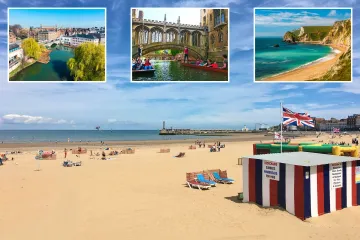The trending UK destination where you can spot dolphins from the beach
A city in the UK has seen a rise in demand for holidays – and it is surprisingly affordable.
Despite its nickname the ‘Granite City‘ Aberdeen is filled with pretty shopping streets as well as sandy beaches.
Booking.com revealed it to be the biggest hotspot for UK travellers in 2025 with an increased search of 36 per cent – and it will no doubt continue to be visited next year.
Union Street was once used to connect medieval streets to the Scottish countryside, but now it’s filled with shops and restaurants and is close to the train station.
One writer who visited Aberdeen recommends heading to Thistle Street for boutique and trinket shops.
And you must try a buttery for breakfast – which is a crispy, flat, flaky pastry, rich in salt, and one great spot to pick one up is Ross Bakery on Chapel Street.
Other impressive spots nearby include the Aberdeen Maritime Museum, art gallery, Duthie Park and St Machar’s Cathedral.
Despite it being a big city, Aberdeen actually has very impressive beaches too and they are just 20 minutes away from the city centre if you walk – and even quicker by car.
If you’re lucky enough, there’s a chance of spotting a Bottlenose dolphin which live off the coast in the north east of Scotland.
Aberdeen Beach could soon get a new attraction too with a ‘play factory’ for kids and an outdoor performance area.
Most read in Best of British
As part of a multi-million pound project called the ‘Beach Masterplan’, Aberdeen Beach is set to introduce a huge play area for kids called The Rope Factory, with images showing climbing structures, swings and slides.
There will be interactive displays as well as activities and events taking place at the park.
For places to stay, check out UK’s best value hotel which you’ll also find in Aberdeen.
Earlier this year, The Marcliffe Hotel and Spa in Scotland was crowned ‘the best ever we’ve ever stayed at’ by Which? thanks to its rock bottom prices.
The luxury Aberdeen hotel opened in 1993 and was given top praise, thanks to its value for money.
Which? sent in an undercover inspector to scope out the hotel, where they anonymously scouted out everything from cleanliness, to room quality, facilities, location, customer service and value for money.
The five-star hotel is found on the outskirts of Aberdeen and is a huge Victorian manor house.
Inside, the hotel has 40-rooms and suites, gym, an on-site spa and even a billiard room where guests can try their hand at snooker.
It has two restaurants, the Conservatory and the Drawing Room Bar and Lounge – both of which have over 300 wines and 100 whiskies.
Marcliffe impressed Which? with its “value”, “elegance” and “exceptional staff” as well as “locally caught” food from langoustines to steak – the start from £25.
A stay in one of Marcliffe’s ‘classic’ rooms costs £180 per night.
For more on Scotland find out one man’s favourite of the 100 Scottish islands – and the ones that rival Skye.
Plus, Scotland’s most unmissable places according to a local – from lesser-known lochs to ‘magical’ islands.


